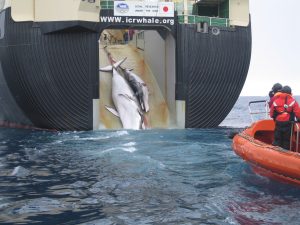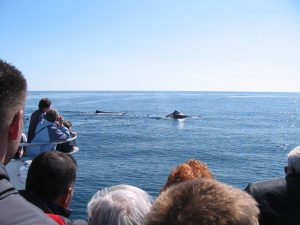The Good, The Bad and The Ugly: A comparison between Whaling and Whale Watching
by Pat Goebel, RJD Intern
The profitability of a live whale compared to a dead whale has greatly increased over the last decade. Since the banning of commercial whaling, whale watching tourism has become a $2.1 billion dollar industry (Kuo 2011). As of 2008, 13 million people participated in whale watching in 119 countries, ranging from Norway to South Africa to Tonga, generating an expenditure of $2.1 billion (O’ Connor et al 2009). The value of a live whale substantially outweighs the production of a dead whale. Despite the significant difference, there are several countries that still participate in whaling.
A whaling moratorium was passed in 1986 as a means to protect and establish a sustainable whale fishery. However, Japan, Norway and Iceland all actively hunt whales either for “scientific research” or legalized whaling. In Japan, the whaling program/industry is worth $31.1 million. At the same time whale watching in Japan is estimated to be at $33.0 million (Parson 2013). However, in Norway, whale watching is estimated to be worth more than double the whaling industry. Therefore, it is evident that countries such as Norway have not realized the profitability of the whale watching industry.
Whaling is not only less profitable but may negatively affect the whale watching industry. Whaling reduces the number of whales available for watching, may disturb or alter the regular activities of whales, leads to negative attitudes of whale watchers or potential tourists toward whaling, and decreases the satisfaction for whale watchers (Kuo 2011, Hoyt and Hvenegaard 2002). Several surveys have shown that whale watching tourists actively avoid countries that hunt whales. For example, one survey of whale watchers in the United Kingdom found 79% of whale watching tourists would boycott visiting a country that conducted hunts for cetaceans (Parson 2013). The Japanese whale watching industry would most likely increase with the demise of whaling. An increase in whale watching tourism will not only help conserve whales but will also increase the overall income of Japan. Tourism distributes money horizontally throughout the area because tourists spend money on items such as hotels, food, cars, and site seeing.
Whale watching is clearly a more desirable and profitable use of whales than harvesting. However, there are some negative impacts. Whale watching can have direct and indirect effects on whales. The biggest direct threat is collisions between whales and whale watching vessels. This problem is growing due to the increase in traffic and faster boats. The industry continues to grow and more boats are entering the water now more than ever. There are reports dating to as early as the 1800s of ships hitting and killing whales. Noise pollution from whale watching boats is another problem. In an area with a lot of background noise, killer whales have been found to modify the frequency of their echolocation clicks, so their clicks are not obscured or masked by the noise of the environment. While such frequency changes may allow clicks to better stand out from background noise, it also changes the range or resolution of the clicks (Parson 2013). Either way may reduce the efficiency with which a killer whale can find food or acoustically see in the marine environment. Therefore, whales may change surfacing time, swimming behavior, direction, group size, and coordination as well (Parson 2013). All of the changes may cause the animals to increase their energy expenditure. In whale watching hot spots, whales can be followed in great numbers for great durations. For example, the southern resident killer whale population is followed on average by 20 vessels for approximately 12 hours per day from May to September (Lachmuth et al 2011). You can think of the whales as celebrities and the boats as TMZ/ paparazzi. Celebrities are constantly in the spotlight being followed and nagged. In some cases they will change their route or time of day they depart their house in order to avoid the paparazzi. Also, some celebrities handle the lime-light/stress better than others and I would predict this is true of whale species. Lets just hope none of them go off the deep end like Miley Cyrus.
There has been a lack of regulations in whale watching industry. The implementation of rules has not kept up with the rapid growth. Recently, rules and regulations have been put in place in some countries as a way to protect the whales and ensure safe boating. However, the effort to enforce the regulations is lacking and many operators are not following them correctly. For example, a study conducted in Australia found that operators complied with only one of four guidelines (Parson 2013). I believe installing refuges or protected areas would be a very efficient way of protecting whales. These refuges allow animals to feed, hunt and rest without any anthropogenic disturbance.
There are clear differences between the whaling industry and the whale-watching industry. Both industries can impact the environment and whales negatively, but only the whaling watching industry can have a positive effect as well. The implementation of rules and regulations will have a significant effect on reducing the negative impacts of whale watching. The direct killing and slaughtering of whales will never provide an economic value as substantial as whale watching.
REFERENCES
Kuo, Hsiao-I., Chi-Chung Chen, and Michael McAleer. Estimating the impact of whaling on global whale-watching. Tourism Management 33, no. 6 (2012): 1321-1328.
PARSONS, E.C.M. An Introduction to Marine Mammal Biology and Conservation. Burlington, MA. Jones and Bartlett Learning, LLC. (2013)
O’Connor, Simon, R. Campbell, H. Cortez, and T. Knowles. Whale Watching Worldwide: Tourism numbers, expenditures and economic benefits. (2009).Hoyt, Erich, and Glen T. Hvenegaard. A review of whale-watching and whaling with applications for the Caribbean. Coastal Management 30, no. 4 (2002): 381-399.
Lachmuth, Cara L., Lance G. Barrett-Lennard, D. Q. Steyn, and William K. Milsom. Estimation of southern resident killer whale exposure to exhaust emissions from whale-watching vessels and potential adverse health effects and toxicity thresholds. Marine pollution bulletin 62, no. 4 (2011): 792-805.
Hoyt, Erich, and Glen T. Hvenegaard. A review of whale-watching and whaling with applications for the Caribbean. Coastal Management 30, no. 4 (2002): 381-399.



